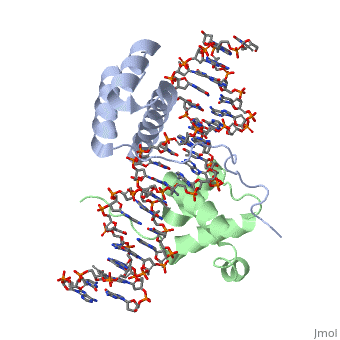Tyrone Evans Hox Proteins sandbox
From Proteopedia
(Difference between revisions)
| Line 6: | Line 6: | ||
Hox Proteins are transcription factors, proteins that are involved in the process of transcribing DNA into RNA. These specific types of proteins are capable of binding to enhancers, a short (50-1500 bp) region of DNA, in pursuit of activating or repressing certain genes. These proteins are named this way because of the mutations that are done within them that cause homeotic transformations, changing of an organ into another. | Hox Proteins are transcription factors, proteins that are involved in the process of transcribing DNA into RNA. These specific types of proteins are capable of binding to enhancers, a short (50-1500 bp) region of DNA, in pursuit of activating or repressing certain genes. These proteins are named this way because of the mutations that are done within them that cause homeotic transformations, changing of an organ into another. | ||
| - | == Role in Development == | + | == Role in Development<ref>Freeman, Quillin, and Allison. Biological Science. 5th ed. Vol. 1. N.p.: Benjamin Cummings, n.d. Print. |
| + | </ref> == | ||
As mentioned previously, homeotic transformations can alter DNA sequences so that specific proteins will have different functions, and certain genes will be either activated or deactivated. More specifically, if a certain hox protein is responsible for the development of legs on a fly in the middle region of its body, a homeotic transformation can cause this protein to carry out this same function in a different area. In this example, this altered protein can activate the gene for leg development to change the antennae to legs on that fly's head, as seen in multiple experiments. And biologists believe this to be true for Hox genes in flies, mice, humans, and other animals. | As mentioned previously, homeotic transformations can alter DNA sequences so that specific proteins will have different functions, and certain genes will be either activated or deactivated. More specifically, if a certain hox protein is responsible for the development of legs on a fly in the middle region of its body, a homeotic transformation can cause this protein to carry out this same function in a different area. In this example, this altered protein can activate the gene for leg development to change the antennae to legs on that fly's head, as seen in multiple experiments. And biologists believe this to be true for Hox genes in flies, mice, humans, and other animals. | ||
Revision as of 18:07, 3 November 2015
Hox Proteins
| |||||||||||

